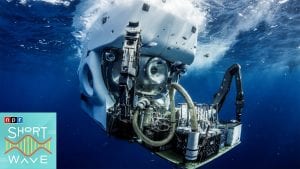A Quick Dive Into How Submarines Work
Submarines can descend thousands of feet below the surface of the ocean, but to do so, they have to deal with an enormous amount of pressure. NPR caught up with WHOI’s Bruce Strickrott, Group Manager and Chief Pilot of the Deep Submergence Vehicle Alvin, who explains some of the fundamental engineering principles that allow submarines to dive so deep without imploding under the pressure, and shares updates on Alvin’s overhaul and future dives.
Human Occupied Vehicle (HOV) Alvin is part of the National Deep Submergence Facility (NDSF). Alvin is one of the most recognized deep submergence vessels in the world and the only one in the U.S. capable of carrying humans into extreme ocean depths. The sub has completed 5,065 successful dives, more than all other submersible programs worldwide combined. When Alvin relaunches next fall, the iconic sub will have the ability to dive to 6500 meters (21,325 feet)—almost 4 miles deep and 2,000 meters deeper than Alvin’s current maximum depth of 4500 meters (14,800 feet). The upgrade will also give the sub access to 99% of the ocean floor.

